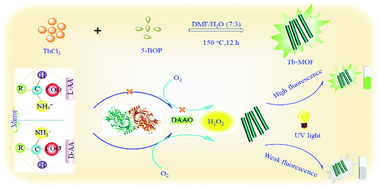Stereospecific recognition and rapid determination of d-amino acids in human serum based on luminescent metal–organic frameworks†
Abstract
The current luminescent metal–organic framework (MOF) based fluorescence detection mostly focuses on achiral molecules. The stereospecific recognition and determination of MOF-based detection remain challenging. A novel luminescent terbium-based MOF (Tb-MOF) based biosensing system with excellent performance for stereoselective detection of D-amino acids (D-AAs) was introduced in this paper. D-Amino acid oxidase catalyzes stereospecific oxidative deamination of D-AAs, producing H2O2. The generated H2O2 effectively quenches the fluorescence of Tb-MOF. Under optimum conditions, the D-AAs were detected with excellent efficiency. The linear working range was 0.5–100 μM for D-Alanine (D-Ala) and 0. 5–5 μM for D-Proline (D-Pro), respectively. The limit of detection (Ksv detection) for D-Ala and D-Pro was 0.09 μM and 0.14 μM, respectively. The detection can be performed within 30 min with high selectivity and long-term stability. The fluorescent sensing platform required simple fabrication and operation and was free from complicated reaction processes and expensive reagents. The present sensing system was successfully applied in D-AA detection in human serum with good recovery, indicating its potential application in detection in biological samples.



 Please wait while we load your content...
Please wait while we load your content...